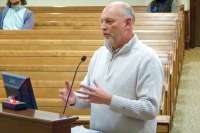WCU takes on tourism with inaugural conference
 The takeaway from Western Carolina University’s inaugural Tourism Works conference was pretty straightforward.
The takeaway from Western Carolina University’s inaugural Tourism Works conference was pretty straightforward.
“I don’t think tourism gets enough credit for what it does for county economies, and I think it’s about time it did,” summed up Steve Morse. “In Western North Carolina, tourism is economic development.”
As director of the WCU College of Business’s Hospitality and Tourism program, Morse presided over the day-long conference held April 11. The event drew more than 130 people from around the region. In addition to representatives from the area’s tourism industry, participants included elected officials and individuals interested in economic development.
“It was great, it was a wonderful first conference,” said Anna Smathers, communications manager for the Haywood County Tourism Development Authority. “It was a lot about building relationships and working together.”
The focus of the conference was tourism’s impact on local economies. To that end, students in WCU’s Tourism and Hospitality program compiled relevant statistics for each of North Carolina’s western counties.
Related Items
Attendants were presented with a conference workbook brimming with a collection of data for each county. The stats were striking. In Swain County, annual tourism spending is pegged at about $293 million. Almost $17 million in state and local taxes is generated each year in Macon County by tourists. Jackson County sees about $11 million each year in tourism-related income and paychecks. More than 1,300 jobs in Haywood County are related to the tourism trade.
“Tourism is a huge industry for us, and here are the numbers showing the effect of it,” Smathers said.
Morse encouraged people to share his students’ data. He implored them to do so.
“You need to tell that story often, you need to tell it as much as possible,” the director said.
Conference attendees were given suggestions about how best to illustrate the impact of tourism on local economies. One suggestion involved drawing up an oversized, photo-op check featuring the dollar amount that each household would need to pony up to equal the amount of money tourism generates in taxes each year.
“That’s a great way to show it,” Morse said, holding up a large check displaying Haywood’s theoretical household amount: $325.
Conference-goers also heard from Witt Tuttle, N.C. Department of Commerce’s assistant secretary, Division of Tourism, Film and Sports Development. He laid out the state’s tourism strategies and discussed the evolving world of tourism marketing.
“Twenty or 30 years ago, it was pretty easy — you did a print ad, you did a radio ad, you were done,” he said, explaining that web-based marketing may play much better these days. “We’ve gone 60 percent digital. We want to get’em while they plan.”
Tuttle also spoke about the amount of funds dedicated to marketing North Carolina. It’s less than that spent on such efforts in Florida. It’s considerably less than is expended in Tennessee and South Carolina, where more than $20 million is put toward marketing.
“We’re at about $9.5 million, so that scares me,” Tuttle said. “South Carolina has so much money they’re spending a million dollars on a barbecue trail. C’mon, barbecue? That’s us. You can’t steal that from us.”
David Primm, of Primm Research out of Pennsylvania, spoke about the economic importance of the designated Blue Ridge National Heritage Area. He noted that of the United State’s 49 national heritage areas, 12 are in the Southeast, but only one is in North Carolina.
Primm’s calculations show that the designation annually generates 30,000 jobs, $176.5 million in state and local taxes and $2.39 billion for the economy.
Toward the end of the conference, WCU Chancellor David Belcher stopped by. He commended the attendees for tackling a “critical issue that’s incredibly important.”
“I know you’ve got a lot of great minds here,” Belcher said. “I’m thrilled to see our hospitality and tourism team taking the lead and hosting this today.”
Another big takeaway from the recent conference was teamwork. Attendees were encouraged to work together. Tourists, they were told repeatedly, do not recognize county or state boundaries. When people visit the Smokies, they don’t care if they are in Western North Carolina or Tennessee.
“They want to experience something as a whole,” stressed John Whisenant, director of tourism for the Tennessee Hospitality and Tourism Association.
That was a point that stuck with Smathers and the rest of Haywood’s TDA team that attended the conference.
“Tourists, they don’t care where the border is between Haywood County and Buncombe County, or Jackson County,” Smathers said. “They’re here for the experience. Let’s break down these borders and let’s work together. “
The tourism trade is traditionally a competitive industry. But the attendees at WCU’s conference appear to be warming to a regional approach.
“You could tell there was a lot of love in the room,” Smathers said. “That sounds corny, but there really was.”









